check engine TOYOTA COROLLA HATCHBACK 2022 (in English) Service Manual
[x] Cancel search | Manufacturer: TOYOTA, Model Year: 2022, Model line: COROLLA HATCHBACK, Model: TOYOTA COROLLA HATCHBACK 2022Pages: 758, PDF Size: 155.26 MB
Page 480 of 758
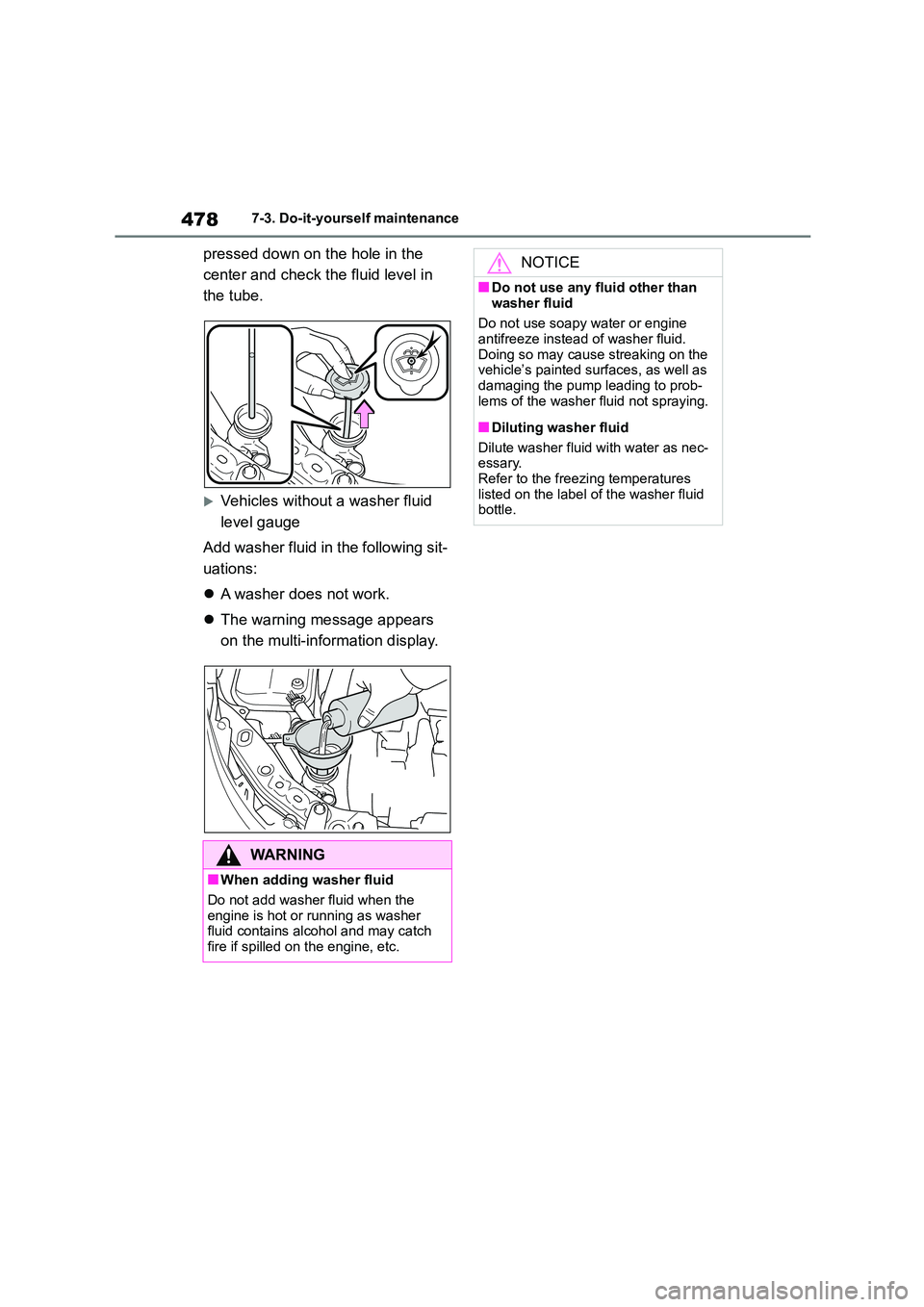
4787-3. Do-it-yourself maintenance
pressed down on the hole in the
center and check the fluid level in
the tube.
ï”Vehicles without a washer fluid
level gauge
Add washer fluid in the following sit-
uations:
ïŹ A washer does not work.
ïŹ The warning message appears
on the multi-information display.
WA R N I N G
â When adding washer fluid
Do not add washer fluid when the engine is hot or running as washer
fluid contains alcohol and may catch
fire if spilled on the engine, etc.
NOTICE
â Do not use any fluid other than
washer fluid
Do not use soapy water or engine antifreeze instead of washer fluid.
Doing so may cause streaking on the
vehicleâs painted surfaces, as well as damaging the pump leading to prob-
lems of the washer fluid not spraying.
â Diluting washer fluid
Dilute washer fluid with water as nec-
essary.
Refer to the freezing temperatures listed on the label of the washer fluid
bottle.
Page 491 of 758
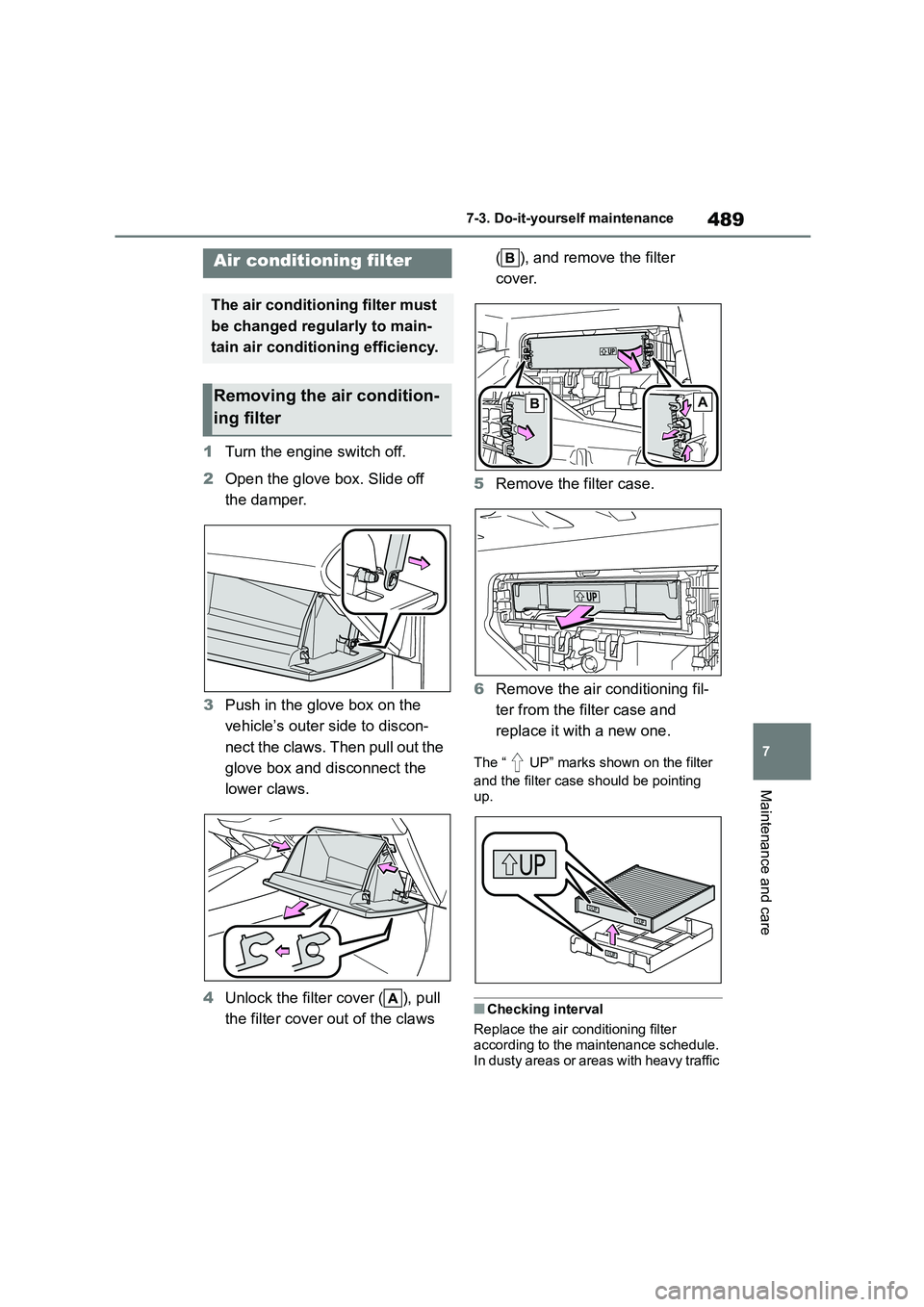
489
7
7-3. Do-it-yourself maintenance
Maintenance and care
1 Turn the engine switch off.
2 Open the glove box. Slide off
the damper.
3 Push in the glove box on the
vehicleâs outer side to discon-
nect the claws. Then pull out the
glove box and disconnect the
lower claws.
4 Unlock the filter cover ( ), pull
the filter cover out of the claws
( ), and remove the filter
cover.
5 Remove the filter case.
6 Remove the air conditioning fil-
ter from the filter case and
replace it with a new one.
The â UPâ marks shown on the filter
and the filter case should be pointing
up.
â Checking interval
Replace the air conditioning filter
according to the maintenance schedule.
In dusty areas or areas with heavy traffic
Air conditioning filter
The air conditioning filter must
be changed regularly to main-
tain air conditioning efficiency.
Removing the air condition-
ing filter
AB
Page 496 of 758
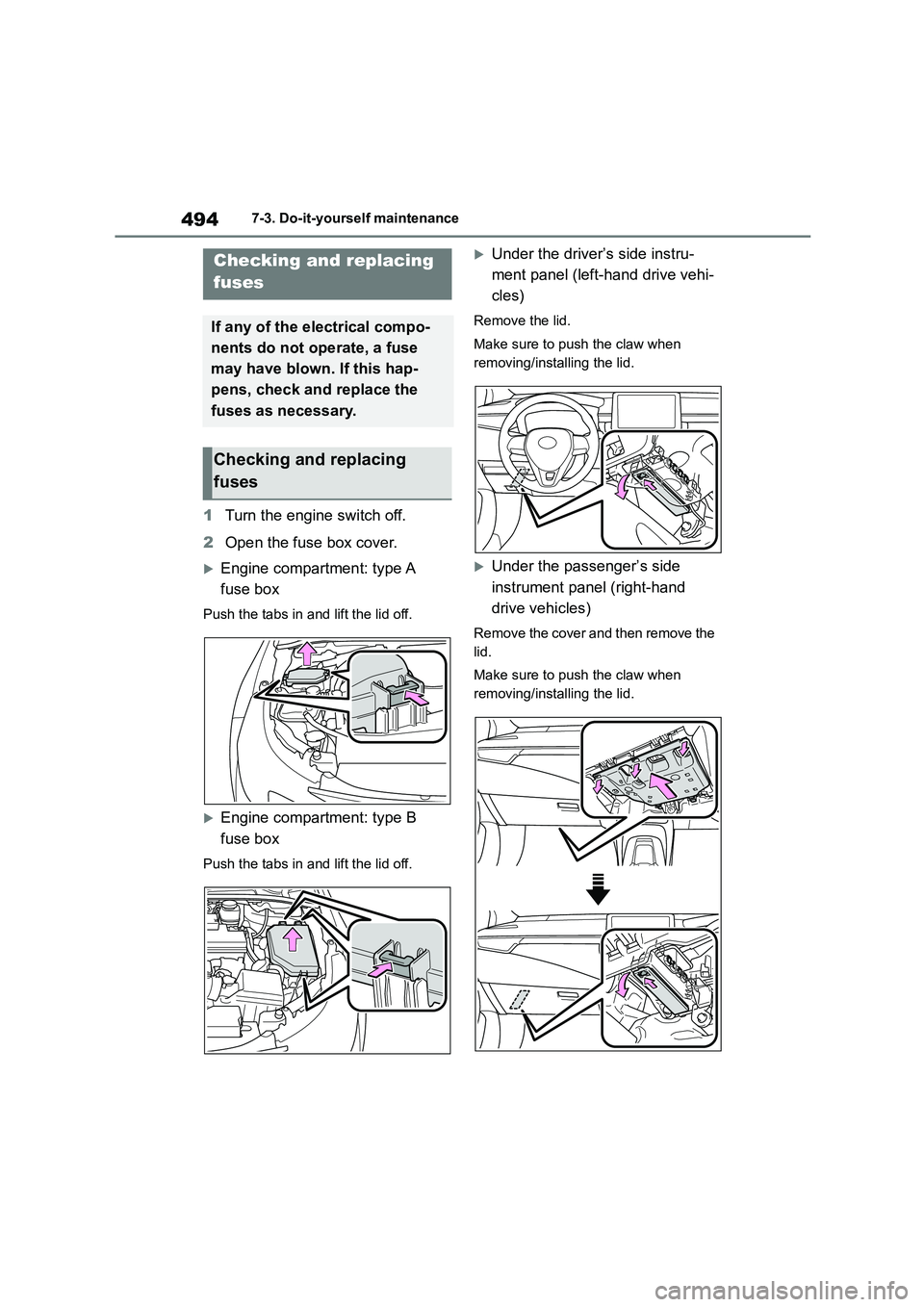
4947-3. Do-it-yourself maintenance
1Turn the engine switch off.
2 Open the fuse box cover.
ï”Engine compartment: type A
fuse box
Push the tabs in and lift the lid off.
ï”Engine compartment: type B
fuse box
Push the tabs in and lift the lid off.
ï”Under the driverâs side instru-
ment panel (left-hand drive vehi-
cles)
Remove the lid.
Make sure to push the claw when
removing/installing the lid.
ï”Under the passengerâs side
instrument panel (right-hand
drive vehicles)
Remove the cover and then remove the
lid.
Make sure to push the claw when
removing/installing the lid.
Checking and replacing
fuses
If any of the electrical compo-
nents do not operate, a fuse
may have blown. If this hap-
pens, check and replace the
fuses as necessary.
Checking and replacing
fuses
Page 520 of 758
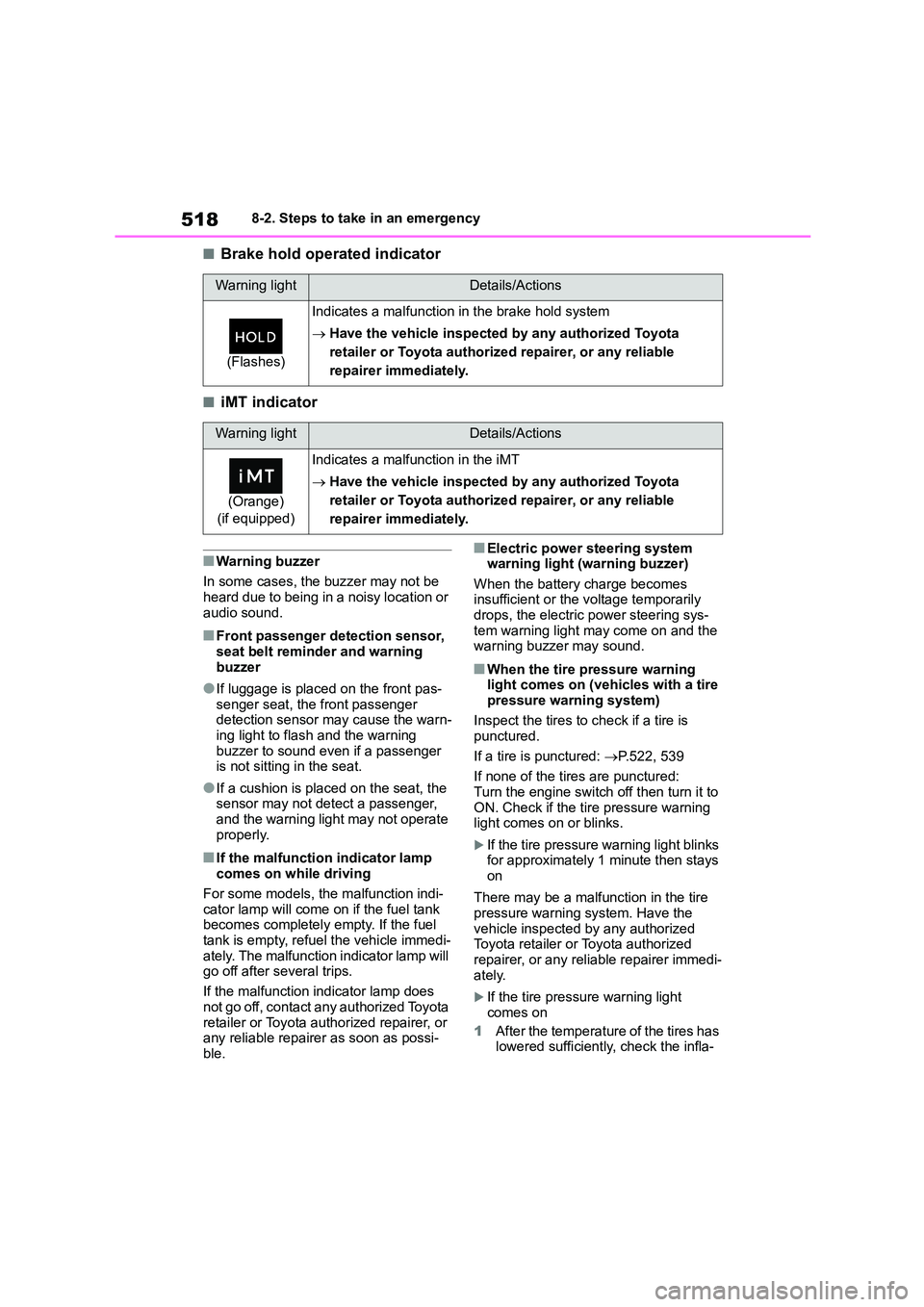
5188-2. Steps to take in an emergency
â Brake hold operated indicator
â iMT indicator
â Warning buzzer
In some cases, the buzzer may not be
heard due to being in a noisy location or audio sound.
â Front passenger detection sensor,
seat belt reminder and warning
buzzer
âIf luggage is placed on the front pas-
senger seat, the front passenger detection sensor may cause the warn-
ing light to flash and the warning
buzzer to sound even if a passenger is not sitting in the seat.
âIf a cushion is placed on the seat, the
sensor may not detect a passenger, and the warning light may not operate
properly.
â If the malfunction indicator lamp
comes on while driving
For some models, the malfunction indi-
cator lamp will come on if the fuel tank
becomes completely empty. If the fuel tank is empty, refuel the vehicle immedi-
ately. The malfunction indicator lamp will
go off after several trips.
If the malfunction indicator lamp does
not go off, contact any authorized Toyota
retailer or Toyota authorized repairer, or any reliable repairer as soon as possi-
ble.
â Electric power steering system warning light (warning buzzer)
When the battery charge becomes
insufficient or the voltage temporarily drops, the electric power steering sys-
tem warning light may come on and the
warning buzzer may sound.
â When the tire pressure warning light comes on (vehicles with a tire
pressure warning system)
Inspect the tires to check if a tire is punctured.
If a tire is punctured: ïźP.522, 539
If none of the tires are punctured: Turn the engine switch off then turn it to
ON. Check if the tire pressure warning
light comes on or blinks.
ï”If the tire pressure warning light blinks
for approximately 1 minute then stays on
There may be a malfunction in the tire pressure warning system. Have the
vehicle inspected by any authorized
Toyota retailer or Toyota authorized
repairer, or any reliable repairer immedi- ately.
ï”If the tire pressure warning light comes on
1 After the temperature of the tires has
lowered sufficiently, check the infla-
Warning lightDetails/Actions
(Flashes)
Indicates a malfunction in the brake hold system
ïź Have the vehicle inspected by any authorized Toyota
retailer or Toyota authorized repairer, or any reliable
repairer immediately.
Warning lightDetails/Actions
(Orange)
(if equipped)
Indicates a malfunction in the iMT
ïź Have the vehicle inspected by any authorized Toyota
retailer or Toyota authorized repairer, or any reliable
repairer immediately.
Page 522 of 758
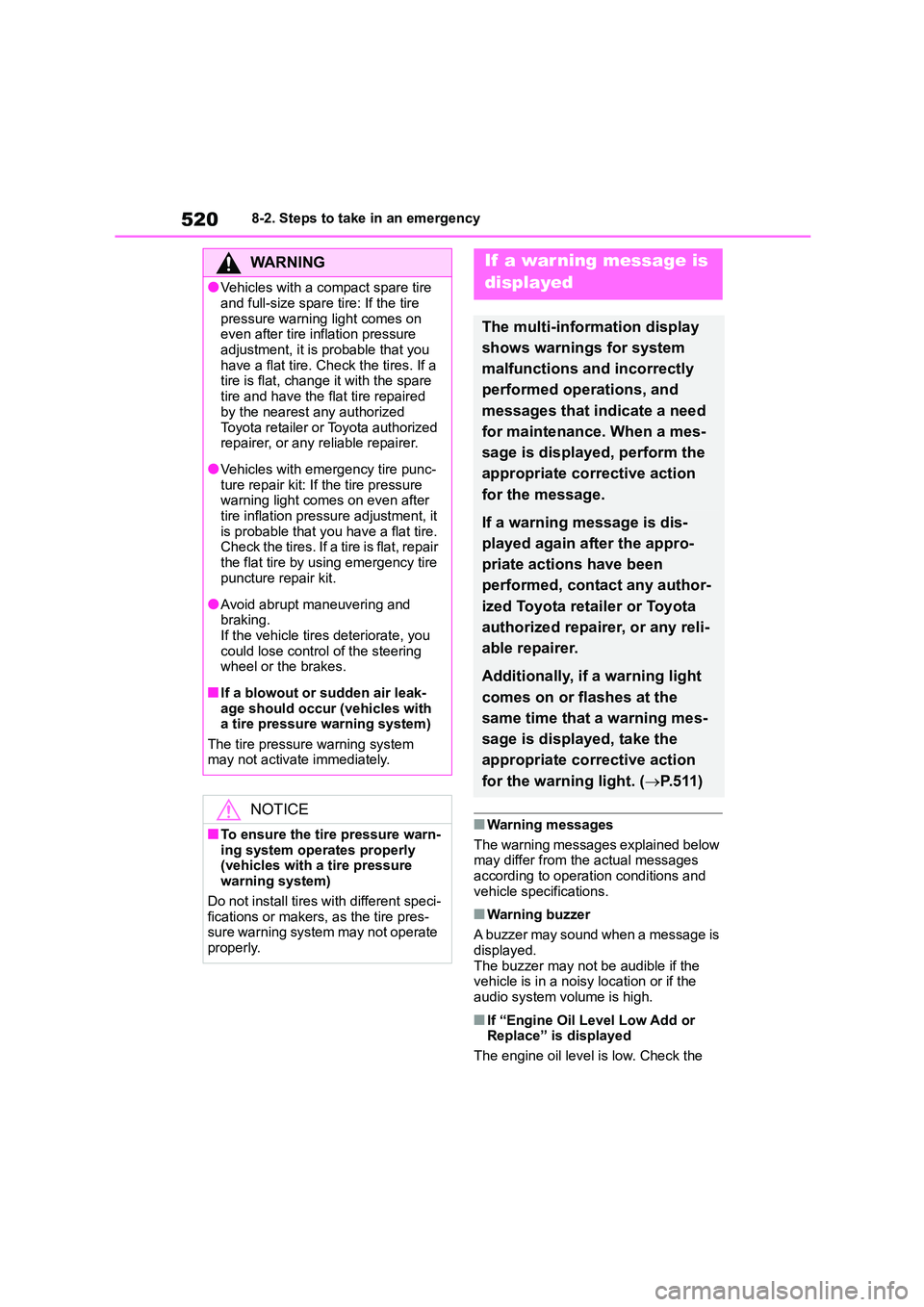
5208-2. Steps to take in an emergency
â Warning messages
The warning messages explained below
may differ from the actual messages
according to operation conditions and vehicle specifications.
â Warning buzzer
A buzzer may sound when a message is
displayed. The buzzer may not be audible if the
vehicle is in a noisy location or if the
audio system volume is high.
â If âEngine Oil Level Low Add or Replaceâ is displayed
The engine oil level is low. Check the
WA R N I N G
âVehicles with a compact spare tire
and full-size spare tire: If the tire
pressure warning light comes on even after tire inflation pressure
adjustment, it is probable that you
have a flat tire. Check the tires. If a tire is flat, change it with the spare
tire and have the flat tire repaired
by the nearest any authorized
Toyota retailer or Toyota authorized repairer, or any reliable repairer.
âVehicles with emergency tire punc-ture repair kit: If the tire pressure
warning light comes on even after
tire inflation pressure adjustment, it is probable that you have a flat tire.
Check the tires. If a tire is flat, repair
the flat tire by using emergency tire puncture repair kit.
âAvoid abrupt maneuvering and braking.
If the vehicle tires deteriorate, you
could lose control of the steering wheel or the brakes.
â If a blowout or sudden air leak-age should occur (vehicles with
a tire pressure warning system)
The tire pressure warning system may not activate immediately.
NOTICE
â To ensure the tire pressure warn-
ing system operates properly
(vehicles with a tire pressure warning system)
Do not install tires with different speci-
fications or makers, as the tire pres- sure warning system may not operate
properly.
If a war ning message is
displayed
The multi-information display
shows warnings for system
malfunctions and incorrectly
performed operations, and
messages that indicate a need
for maintenance. When a mes-
sage is displayed, perform the
appropriate corrective action
for the message.
If a warning message is dis-
played again after the appro-
priate actions have been
performed, contact any author-
ized Toyota retailer or Toyota
authorized repairer, or any reli-
able repairer.
Additionally, if a warning light
comes on or flashes at the
same time that a warning mes-
sage is displayed, take the
appropriate corrective action
for the warning light. ( ïźP.511)
Page 523 of 758
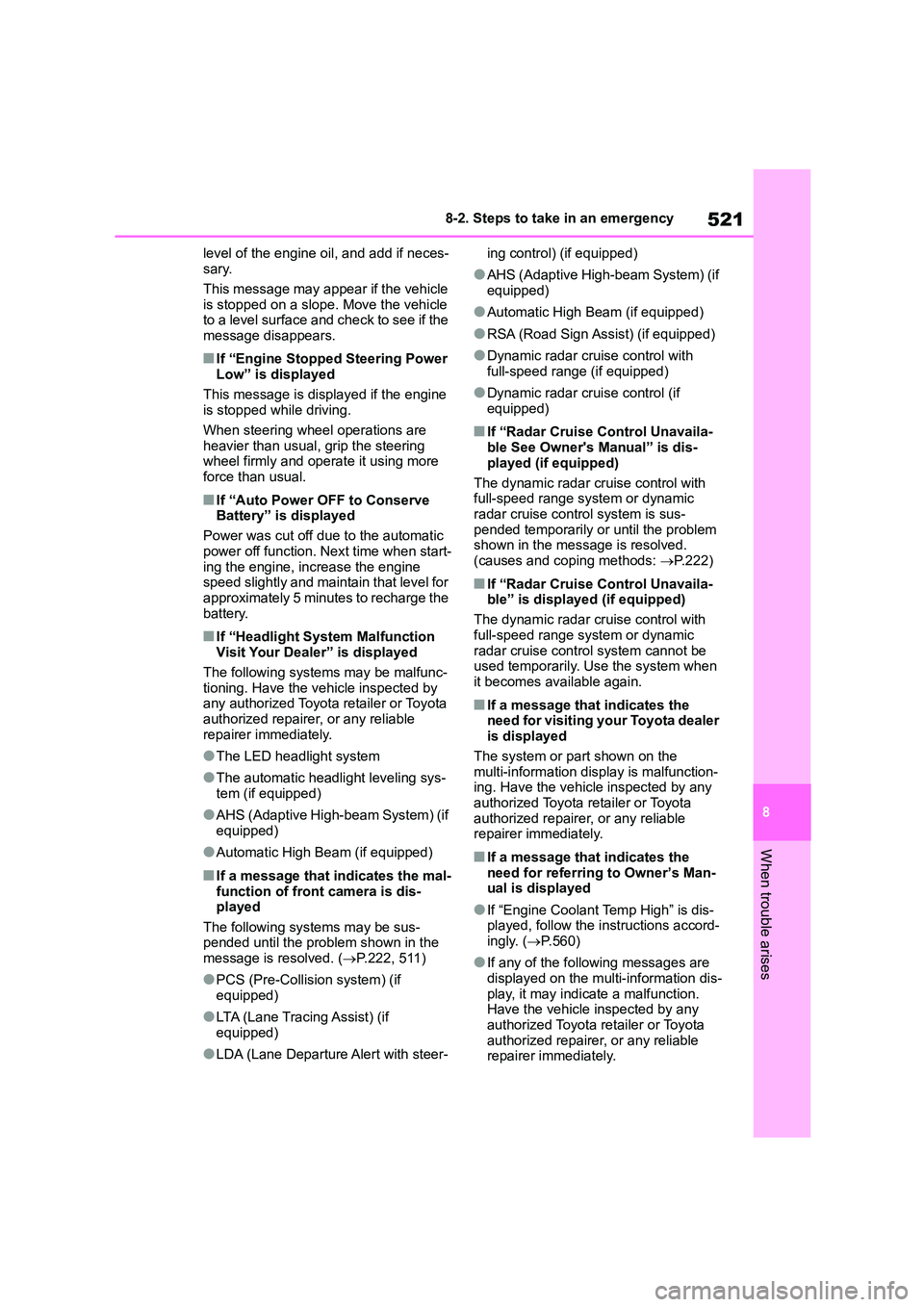
521
8
8-2. Steps to take in an emergency
When trouble arises
level of the engine oil, and add if neces-
sary.
This message may appear if the vehicle
is stopped on a slope. Move the vehicle
to a level surface and check to see if the message disappears.
â If âEngine Stopped Steering Power
Lowâ is displayed
This message is displayed if the engine is stopped while driving.
When steering wheel operations are
heavier than usual, grip the steering wheel firmly and operate it using more
force than usual.
â If âAuto Power OFF to Conserve
Batteryâ is displayed
Power was cut off due to the automatic
power off function. Next time when start-
ing the engine, increase the engine speed slightly and maintain that level for
approximately 5 minutes to recharge the
battery.
â If âHeadlight System Malfunction Visit Your Dealerâ is displayed
The following systems may be malfunc-
tioning. Have the vehicle inspected by any authorized Toyota retailer or Toyota
authorized repairer, or any reliable
repairer immediately.
âThe LED headl ight system
âThe automatic headlight leveling sys-
tem (if equipped)
âAHS (Adaptive High-beam System) (if
equipped)
âAutomatic High Beam (if equipped)
â If a message that indicates the mal-
function of front camera is dis-
played
The following systems may be sus- pended until the problem shown in the
message is resolved. ( ïźP.222, 511)
âPCS (Pre-Collision system) (if
equipped)
âLTA (Lane Tracing Assist) (if
equipped)
âLDA (Lane Departure Alert with steer-
ing control) (if equipped)
âAHS (Adaptive High-beam System) (if
equipped)
âAutomatic High Beam (if equipped)
âRSA (Road Sign Assist) (if equipped)
âDynamic radar cruise control with
full-speed range (if equipped)
âDynamic radar cruise control (if
equipped)
â If âRadar Cruise Control Unavaila- ble See Owner's Manualâ is dis-
played (if equipped)
The dynamic radar cruise control with full-speed range system or dynamic
radar cruise control system is sus-
pended temporarily or until the problem shown in the message is resolved.
(causes and coping methods: ïźP.222)
â If âRadar Cruise Control Unavaila-
bleâ is displayed (if equipped)
The dynamic radar cruise control with
full-speed range system or dynamic
radar cruise control system cannot be used temporarily. Use the system when
it becomes available again.
â If a message that indicates the
need for visiting your Toyota dealer is displayed
The system or part shown on the
multi-information display is malfunction- ing. Have the vehicle inspected by any
authorized Toyota retailer or Toyota
authorized repairer, or any reliable repairer immediately.
â If a message that indicates the
need for referrin g to Ownerâs Man-
ual is displayed
âIf âEngine Coolant Temp Highâ is dis-
played, follow the instructions accord-
ingly. ( ïźP.560)
âIf any of the following messages are
displayed on the multi-information dis- play, it may indicate a malfunction.
Have the vehicle inspected by any
authorized Toyota retailer or Toyota authorized repairer, or any reliable
repairer immediately.
Page 525 of 758
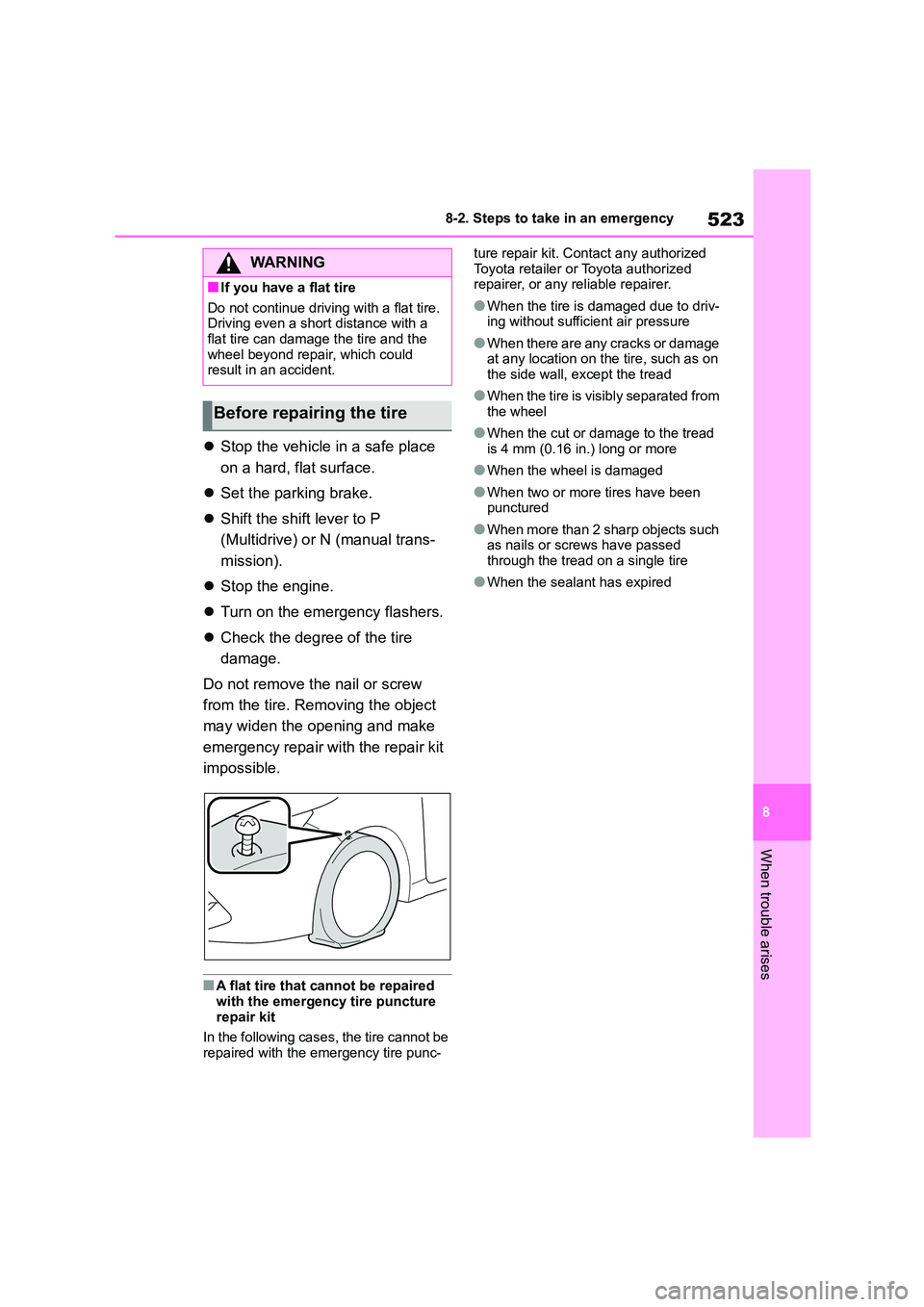
523
8
8-2. Steps to take in an emergency
When trouble arises
ïŹ Stop the vehicle in a safe place
on a hard, flat surface.
ïŹ Set the parking brake.
ïŹ Shift the shift lever to P
(Multidrive) or N (manual trans-
mission).
ïŹ Stop the engine.
ïŹ Turn on the emergency flashers.
ïŹ Check the degree of the tire
damage.
Do not remove the nail or screw
from the tire. Removing the object
may widen the opening and make
emergency repair with the repair kit
impossible.
â A flat tire that cannot be repaired
with the emergency tire puncture repair kit
In the following cases, the tire cannot be
repaired with the emergency tire punc-
ture repair kit. Contact any authorized
Toyota retailer or Toyota authorized repairer, or any reliable repairer.
âWhen the tire is damaged due to driv-ing without sufficient air pressure
âWhen there are any cracks or damage at any location on the tire, such as on
the side wall, except the tread
âWhen the tire is visibly separated from
the wheel
âWhen the cut or damage to the tread
is 4 mm (0.16 in.) long or more
âWhen the wheel is damaged
âWhen two or more tires have been punctured
âWhen more than 2 sharp objects such as nails or screws have passed
through the tread on a single tire
âWhen the sealant has expired
WA R N I N G
â If you have a flat tire
Do not continue driving with a flat tire.
Driving even a short distance with a flat tire can damage the tire and the
wheel beyond repair, which could
result in an accident.
Before repairing the tire
Page 531 of 758
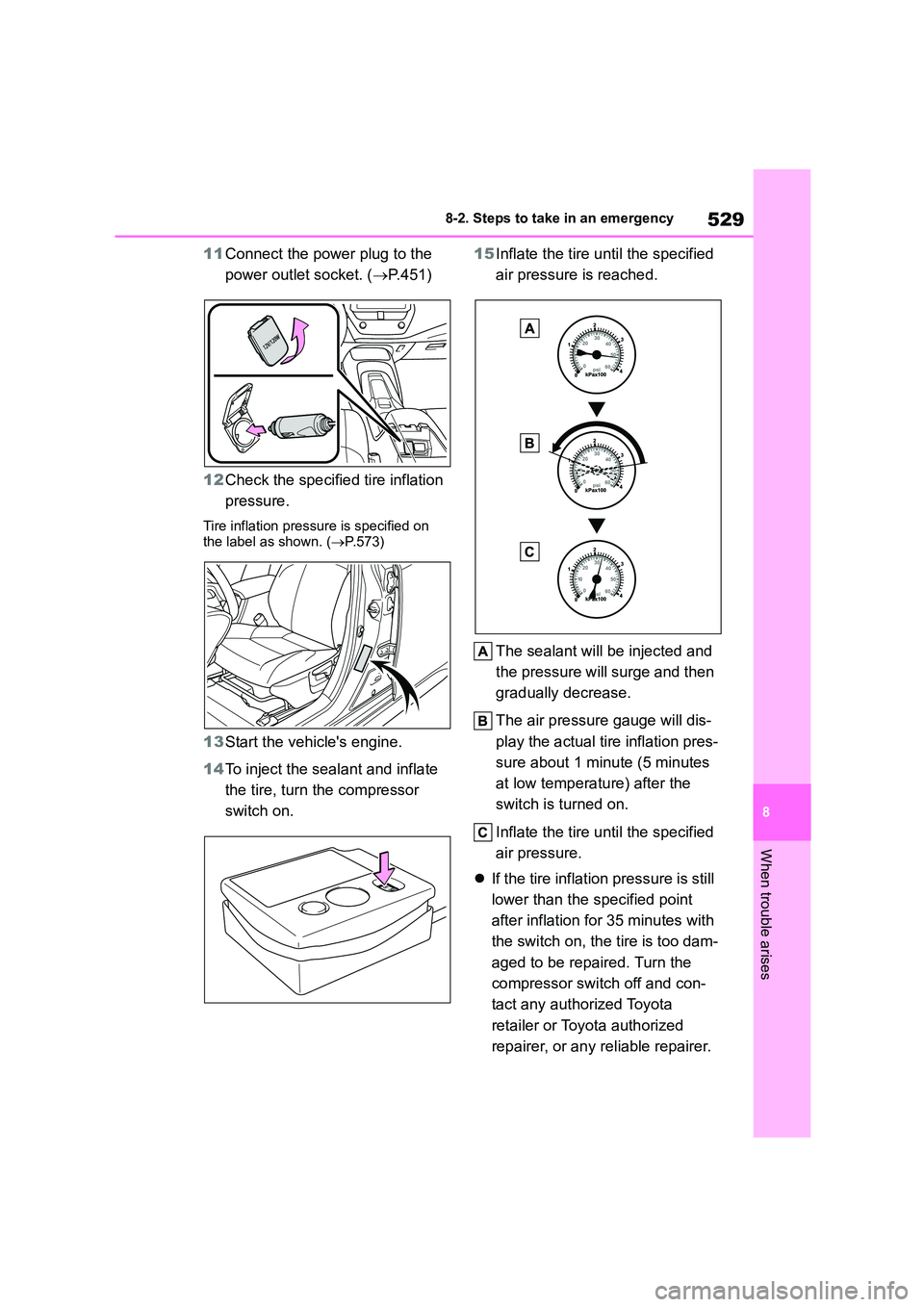
529
8
8-2. Steps to take in an emergency
When trouble arises
11 Connect the power plug to the
power outlet socket. ( ïźP.451)
12 Check the specified tire inflation
pressure.
Tire inflation pressure is specified on the label as shown. ( ïźP.573)
13Start the vehicle's engine.
14 To inject the sealant and inflate
the tire, turn the compressor
switch on.
15 Inflate the tire until the specified
air pressure is reached.
The sealant will be injected and
the pressure will surge and then
gradually decrease.
The air pressure gauge will dis-
play the actual tire inflation pres-
sure about 1 minute (5 minutes
at low temperature) after the
switch is turned on.
Inflate the tire until the specified
air pressure.
ïŹ If the tire inflation pressure is still
lower than the specified point
after inflation for 35 minutes with
the switch on, the tire is too dam-
aged to be repaired. Turn the
compressor switch off and con-
tact any authorized Toyota
retailer or Toyota authorized
repairer, or any reliable repairer.
Page 535 of 758
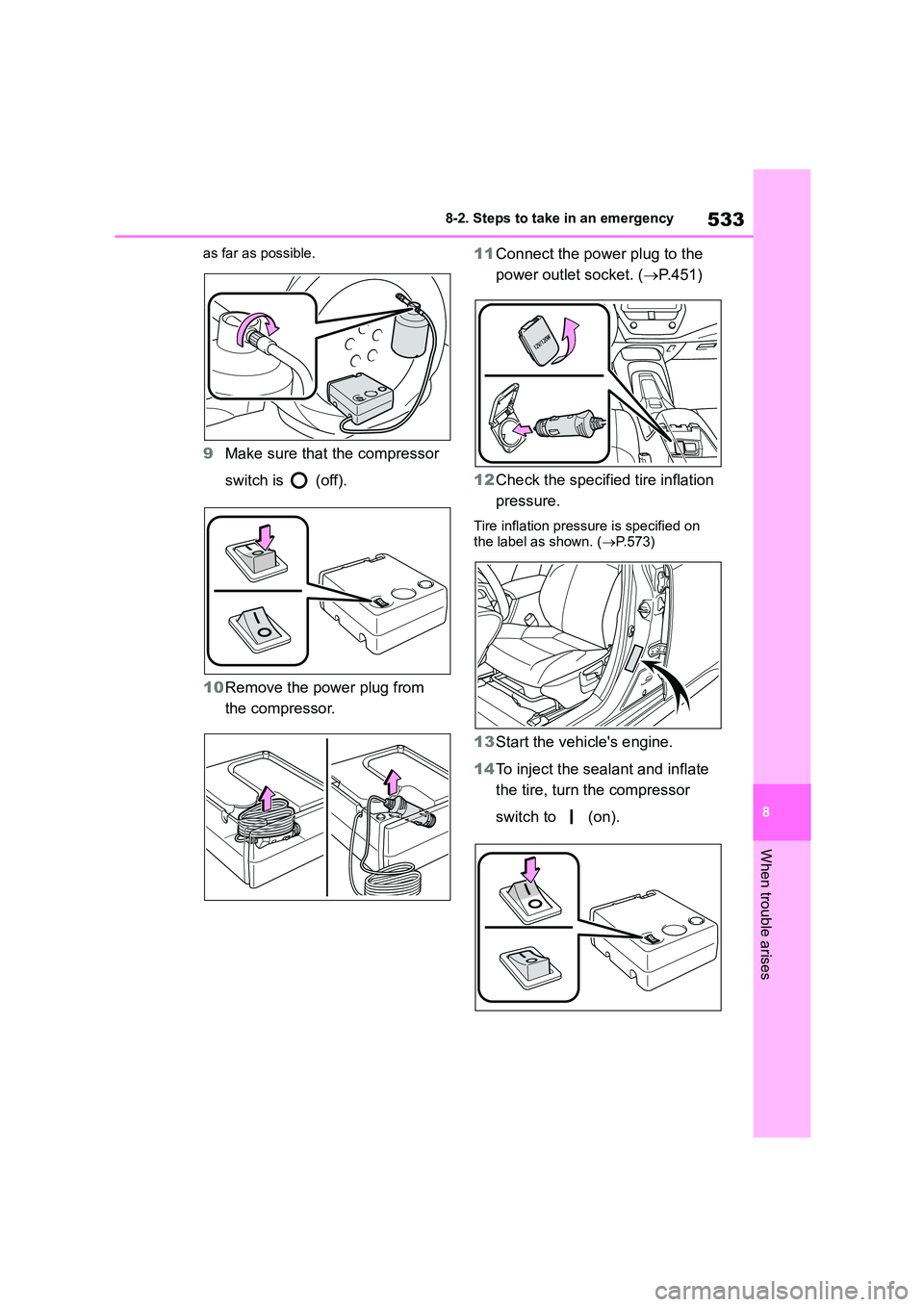
533
8
8-2. Steps to take in an emergency
When trouble arises
as far as possible.
9 Make sure that the compressor
switch is (off).
10 Remove the power plug from
the compressor.
11 Connect the power plug to the
power outlet socket. ( ïźP.451)
12 Check the specified tire inflation
pressure.
Tire inflation pressure is specified on the label as shown. ( ïźP.573)
13Start the vehicle's engine.
14 To inject the sealant and inflate
the tire, turn the compressor
switch to (on).
Page 555 of 758
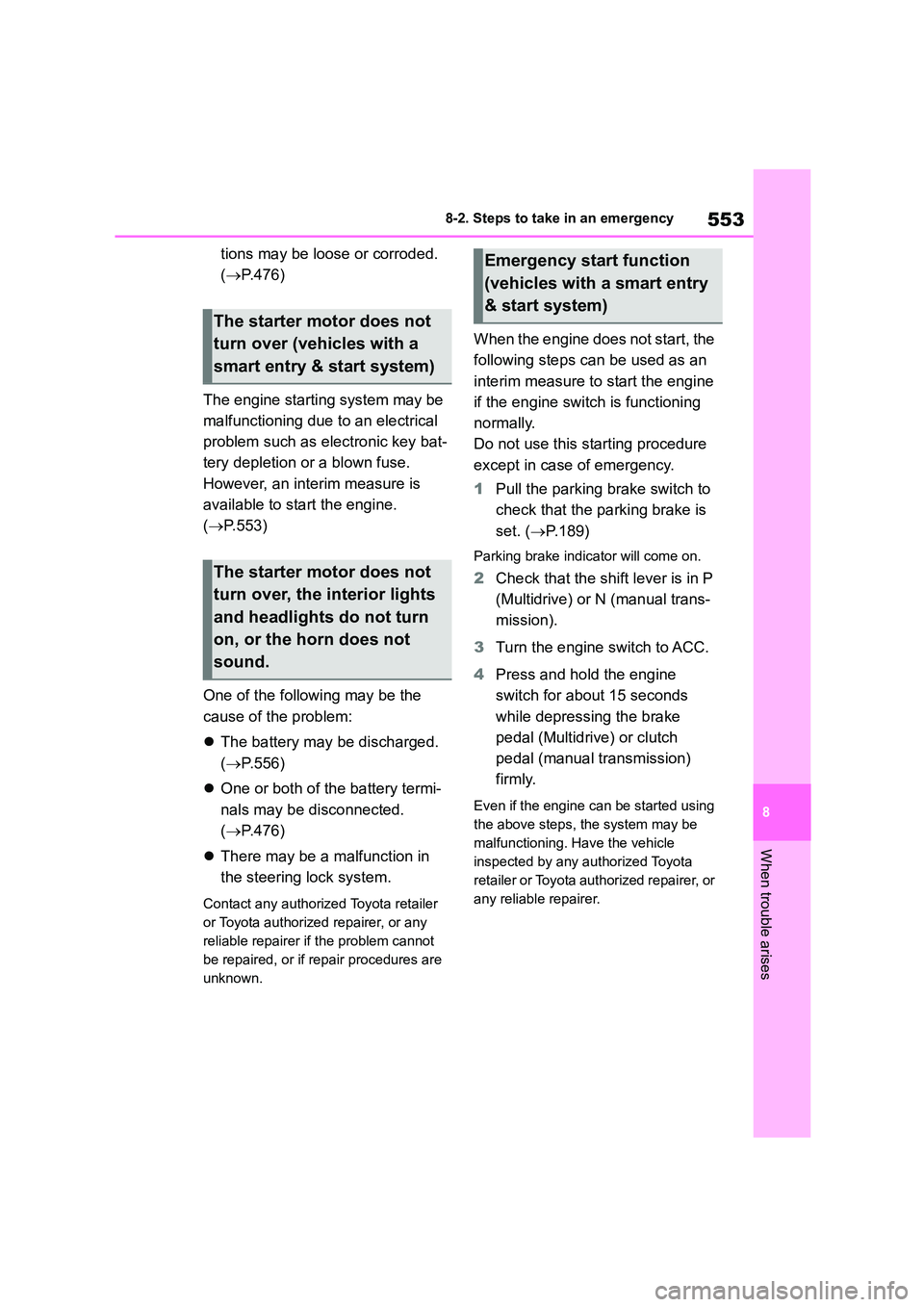
553
8
8-2. Steps to take in an emergency
When trouble arises
tions may be loose or corroded.
( ïźP.476)
The engine starting system may be
malfunctioning due to an electrical
problem such as electronic key bat-
tery depletion or a blown fuse.
However, an interim measure is
available to start the engine.
( ïźP.553)
One of the following may be the
cause of the problem:
ïŹ The battery may be discharged.
( ïźP.556)
ïŹ One or both of the battery termi-
nals may be disconnected.
( ïźP.476)
ïŹ There may be a malfunction in
the steering lock system.
Contact any authorized Toyota retailer
or Toyota authorized repairer, or any
reliable repairer if the problem cannot
be repaired, or if repair procedures are
unknown.
When the engine does not start, the
following steps can be used as an
interim measure to start the engine
if the engine switch is functioning
normally.
Do not use this starting procedure
except in case of emergency.
1 Pull the parking brake switch to
check that the parking brake is
set. ( ïźP.189)
Parking brake indicator will come on.
2Check that the shift lever is in P
(Multidrive) or N (manual trans-
mission).
3 Turn the engine switch to ACC.
4 Press and hold the engine
switch for about 15 seconds
while depressing the brake
pedal (Multidrive) or clutch
pedal (manual transmission)
firmly.
Even if the engine can be started using
the above steps, the system may be
malfunctioning. Have the vehicle
inspected by any authorized Toyota
retailer or Toyota authorized repairer, or
any reliable repairer.
The starter motor does not
turn over (vehicles with a
smart entry & start system)
The starter motor does not
turn over, the interior lights
and headlights do not turn
on, or the horn does not
sound.
Emergency start function
(vehicles with a smart entry
& start system)